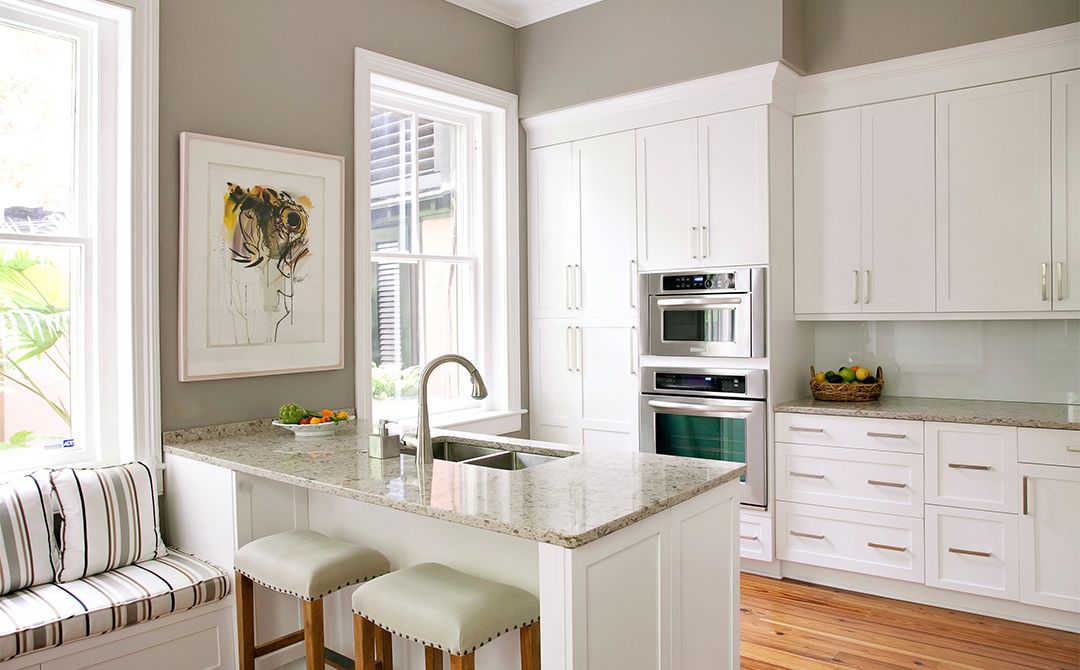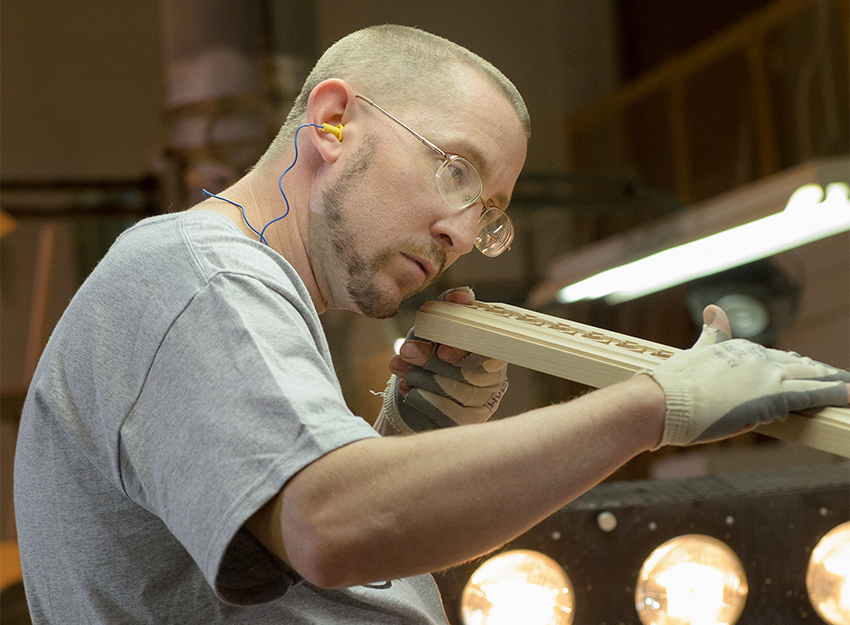
Kitchen Cabinet Construction
Kitchen cabinet construction can vary dramatically however. The better you understand basic construction principles - like face frame or frameless, the more likely you are to select a design that fits your needs and holds up to heavy use.
THE BASICS
The vast majority of kitchen cabinets fall into one of two main design categories: framed and frameless. Framing ultimately determines both the look of the final product and its accessibility.
FRAMED CONSTRUCTION
Featuring a solid frame surrounding the cabinet box's outer edge, framed construction involves multiple pieces fastened to the forward edge. Mortise & tenon construction promotes a strong build that will stand up to heavy use.
Although framed cabinets hold the same basic structure, various subcategories determine how the doors fit with the rest of the cabinet. Top options include:
- Inset. Inset cabinet doors fit flush with the cabinet if closed; as their name implies, they are set inside the cabinet's frame. They offer an attractive appearance in keeping with traditional aesthetics.
- Full-overlay. Like inset, full-overlay doors can provide a smooth aesthetic. But while this is achieved on inset cabinets by setting the door back into the frame, full-overlay doors are designed to completely cover the cabinet's face.
FRAMELESS CONSTRUCTION
Frameless construction is all about maximizing accessibility. The lack of an inside edge prevents the perimeter of the cabinet's opening from being blocked off. Frameless cabinets also tend to offer greater storage space — a clear benefit in small homes and apartments. These stunning cabinets boast a sleek, contemporary appearance that is complemented by their typical full-overlay construction.

BASE VERSUS WALL CABINETS
Cabinet construction is defined not only by the presence or lack of a frame, but also according to the cabinet's location and how it is mounted. Primary options include:
- Base cabinets. Mounted to the floor, these cabinets provide much-needed physical support for countertops. Base cabinets may be located adjacent to the wall or from a kitchen island.
- Wall cabinets. While base cabinets can be located along walls, they are typically anchored to the ground. With wall cabinets, however, the wall itself forms the mount. Typically situated above counters or stoves, these cabinets are not connected to the floor.
- Pantry cabinets. Sometimes referred to as tall cabinets, these essentially are a larger version of the aforementioned base cabinet. Occasionally, they serve as free-standing structures. More often, they're attached to base cabinets or situated adjacent to key kitchen appliances.
MATERIALS: WOOD AND ALTERNATIVES
Wood might seem like a natural first choice for kitchen cabinets, but a variety of other options are available. Often, different parts of the cabinet are created from different materials, as outlined below:
- Particleboard. This engineered wood product is constructed from wood chips and various other particles. A strong adhesive fuses these materials together to form boards and panels. Because particleboard uses a high percentage of recyclable materials, it is increasingly regarded as a top option for eco-friendly homes.
- Medium-density fiberboard. Like particleboard, MDF is an engineered wood product with a promising future in eco-friendly construction. Its fine texture and dense build makes it an excellent option for cabinet shelves, doors, and boxes.
- Plywood. Constructed from thin layers of wood known as plies, this engineered product is primarily used for cabinet shelves and boxes. Plywood's flat structure makes it ideal for seamlessly applying veneers.
- Thermofoil. Typically, cabinets labeled 'thermofoil' are actually constructed from particleboard or plywood — and covered with a thin vinyl film.
- Plastic laminate. This cabinet material resembles the laminate commonly used for countertops. It is thinner, however, when applied to cabinets. Although not commonly used in modern kitchens, it is highly regarded by some for its easy-clean properties.
- Melamine. Like laminate, this plastic-based material is occasionally used as a covering for particleboard cabinet panels. Often, melamine accompanies an affordable and attractive blend of particleboard and wood veneer, with the veneer applied to the outside of the cabinet box.
- Textured melamine. Designed to mimic the look of natural wood, textured melamine offers a rich, three-dimensional aesthetic. Its thermal-fused structure provides greater durability than traditional melamine.
CONSTRUCTION METHODS
Construction methods ultimately determine how cabinets look and whether they hold up to years of heavy use. As you examine different options, you will likely encounter the term 'joinery,' which references the many ways wood parts can be joined to create a durable end product. The following are among the top joinery methods relied upon for modern cabinetry construction:
- Mortise and tenon. As mentioned above, mortise and tenon ensures a strong build. Typically, this method involves a square post that protrudes from a piece of wood. The other piece should include a corresponding square hole. This allows for accurate and durable fastening of the various pieces needed for the face frame.
- Dovetail joints. This common method involves boards joined at right angles. Each end is notched to allow the two panels to join seamlessly. With proper construction, dovetail joints can be exceptionally strong.
- Dado. Featuring a notch cut into the surface of a panel, dado provides a tight fit for the edge of a second panel. This method is primarily used for drawers or shelves.
- Rabbet. Similar to dado construction, a rabbet features a 90-degree notch that is left open. In addition to joining corners, rabbets can be used to hide the cabinet's back.
- Butt joint. Edge-to-edge joining sets butt joints apart. Mechanical retention such as screws or glue are required to hold butt joints together.
- Staples, nails, and screws. Technically, these do not constitute proper joinery. Still, they are frequently relied upon in cabinet construction. If used alone, they can be vulnerable to wear and tear. Often, however, they complement or reinforce tried-and-tested joinery methods.
PARTS WORTH CONSIDERING
As indicated above, different parts of the cabinet call for different materials and joinery methods. Keep the following in mind as you proceed with essential cabinet elements:
- Boxes and Face Frames. Engineered wood products are ideal for cabinet boxes but may be covered with laminates or wood veneers. Ultimately, the box's construction is basic — but advanced joinery methods can ensure that it is properly reinforced to remain as rigid as possible.
- Doors. Commonly constructed from wood or engineered wood, doors grant cabinets much of their visual appeal. Top construction methods include framed and slab. With the former, panel edges float within the frame and can expand or contract as necessary. Slabs typically entail one-piece construction and may be covered with varnishes, thermofoil, or laminate. Check out our wide variety of cabinet door styles here.
- Drawers. In most cases, drawer and case materials mimic one another. Occasionally, however, some drawer parts may be constructed from solid wood to ensure greater durability. Dovetail joints are commonly used for high-quality drawers, although fastening materials such as nails or staples may also be required.
- Shelves. Most shelves are formed from engineered wood products and covered with veneers. The quality of the construction largely depends on the thickness of the shelves and the use or avoidance of reinforcement rails.
FINISHES
Are just important as the construction. A beautifully constructed cabinet's look can quickly be destroyed by the wrong finish. Conversely, a beautiful finish can instantly elevate cabinets. In addition to providing considerable aesthetic appeal, finishes offer essential protection from scratches and dings.

- Paints. Popular in contemporary kitchens, paint provides an unlimited selection of colors.
- Varnishes. As a two-part concealer varnish and topcoat, this look largely depends on the materials and labor involved in producing a product that will endure heat, abrasion, and general exposure in the kitchen environment.
- Stains. An excellent middle ground between paints and varnishes, stains retain the beautiful look of the grain while altering the color of the underlying wood. Sealers and topcoats provide long-term protection.
- Glaze. Applied over paints or stains, glazes provide additional color while highlighting the surface color. When hand-wiped following application, some glaze may be retained in corners and recesses, offering a stunning visual effect.
Dependent on the type of finish used, the finishing process can further refine the cabinet's appearance. The scope of the facility in which the cabinets are finished can ultimately determine the look of the end product. At Plain & Fancy, we enjoy access to a vast 40,000 square foot facility featuring 5000k lights, fresh air intakes, heat curing, and more.
At Plain & Fancy, we're determined to bring your vision to life
A myriad of elements play into the look and function of your kitchen cabinets. A comprehensive approach is essential; all elements should complement one another to ensure the most beautiful and durable structure possible. Contact us today or stop by one of our showrooms to learn more.
Popular
The Key to Organizing your Kitchen
MAY.4.2023Kitchen organization Is the secret to achieving functionality and flow.
Cabinet Door Styles
JAN.9.2023What's In Store for the next Generation? It's no secret that interior design trends are always changing.
Best White Kitchen Cabinet Colors
SEP.23.2019White is currently a top kitchen color, and for good reason — it promotes a bright, open look that can instantly make even the smallest kitchen appear more spacious.
Latest Videos

50 Years As Family In the Kitchen Cabinet Industry
Plain & Fancy is proud to be a family run business, now in its third generation, for over 50 years.

How to Clean Your Plain & Fancy Cabinets
Learn how to properly clean your Plain & Fancy cabinets.

Fit and Finish
Every inset door and drawer are hand fitted one at a time to ensure a perfect fit.
